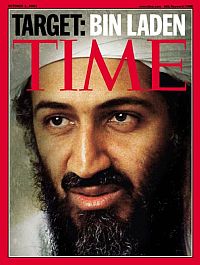 Shortly after 9/11, Osama bin Laden appeared on the cover of Time magazine. What later became an iconic image — the embodiment of evil, global terrorist #1, the face of Islamic extremism, or however else Americans came to view this face — did at the time show a man with an indisputable look of serenity.
Shortly after 9/11, Osama bin Laden appeared on the cover of Time magazine. What later became an iconic image — the embodiment of evil, global terrorist #1, the face of Islamic extremism, or however else Americans came to view this face — did at the time show a man with an indisputable look of serenity.
Since the icons of terrorism were at that juncture still in the process of being manufactured, America’s first glimpses of Public Enemy Number One portrayed — dare I say it — a rather Christ-like figure.
Even though this was still a nation very much in shock, the appearance of a flattering image of the prime suspect behind the attacks was apparently something that America could handle.
Twelve years later and Rolling Stone’s use of a flattering image of Dzhokhar Tsarnaev is now supposedly beyond the pale.
Michelle Malkin, outraged that the magazine’s choice of cover image shows that its “editors are as muddle headed as ever about our war with Islam,” suggests that Rolling Stone is telling America’s youth that Tsarnaev “is just like you!”
And she’s probably right — not on the issue of her war with Islam, but on the idea that Tsarnaev should be seen as an American youth.
He’s just turned 19, he’s a U.S. citizen, he likes hip hop, he’s smoked a lot of weed and he obviously thinks it’s cool to look cool.
This isn’t a land of saints and to belong to the ranks of American youth does not preclude the possibility of doing some awful things before even reaching adulthood. Does ‘cool’ connote any particular virtues? Not that I’ve noticed.
If there’s one thing worth highlighting more than anything else about Tsarnaev, it is precisely his normality. He doesn’t seem to have been unhinged like James Eagan Holmes, Jared Lee Loughner, or Adam Lanza.
Is it disturbing that an ordinary American kid could be involved in a bombing that killed three people and injured many more? Sure.
But that doesn’t mean we now have to plunge into denial and pretend that he wasn’t really an American kid or that there are horns concealed under his locks of hair or that his name or religion makes him foreign.
Osama bin Laden had some Christ-like features and Dzhokhar Tsarnaev looks a bit like Jim Morrison.
Maybe the problem isn’t the images — it’s the simplistic ideas we have about terrorism.


Paul your intelligent words will be lost on the ignorant.
When so many supposedly ‘reasonably’ intelligent people are afraid of photos on a magazine cover, you’ve got to start wondering what sort of world we’ll have when they are finally no longer afraid!
Sadly, majority of the citizenry has swallowed the govt propaganda about “terrorism”, “keeping you safe” and “national security”. How could otherwise one accept the “total lockdown” of a big city with tanks rolling in? Major cities ( London, Bombay) had bomb blasts, more than once and they did not come to a stand still!!
Also, people upset with the photo probably have not read the article and are not asking the question, WHY he became what he became.
It would great to know how everyone including the govt will react to the following!!
http://www.theatlanticwire.com/global/2013/07/edward-snowden-now-pop-art-hero/67374/
On the other hand, someone accused of “aiding the enemy” in headlines….
PRESS RELEASE
International Peace Bureau awards the
Sean MacBride Peace Prize 2013 to
US whistleblower BRADLEY MANNING
19 July 2013
Geneva
http://www.ipb.org/uploads/tbl_noticies_web/225/documents/Read%20IPB%20Press%20Release.pdf
This sort of irrational fear of symbols and imagery isn’t all that different from the Muslim condemnation of other people’s caricatures of Mohammed. It relates to the philosophical dualism that underpins both Christianity and Islam. In the US, it’s exaggerated by the binary thought imported directly into its founding documents, especially the ideal/real binary. Of course, it’s exacerbated through the politics of fear that has nurtured the post-nuclear generations of Americans. Since 9/11, we see that even more exaggerated, to the extent that Americans are *Trapped in the War on Terror*, the title of Ian Lustick’s forthcoming book. You can read an excerpt at:
http://www.upenn.edu/pennpress/book/14285.html